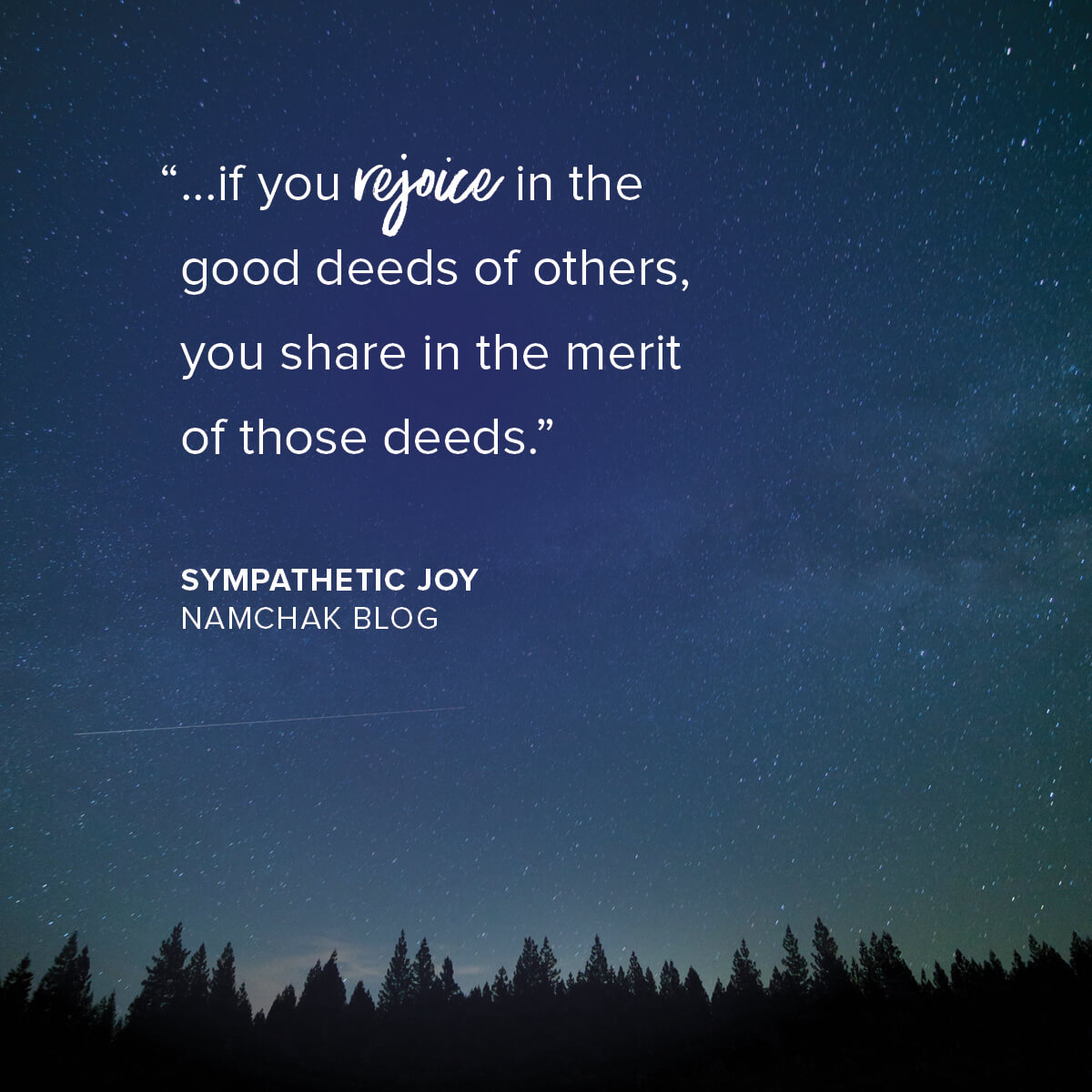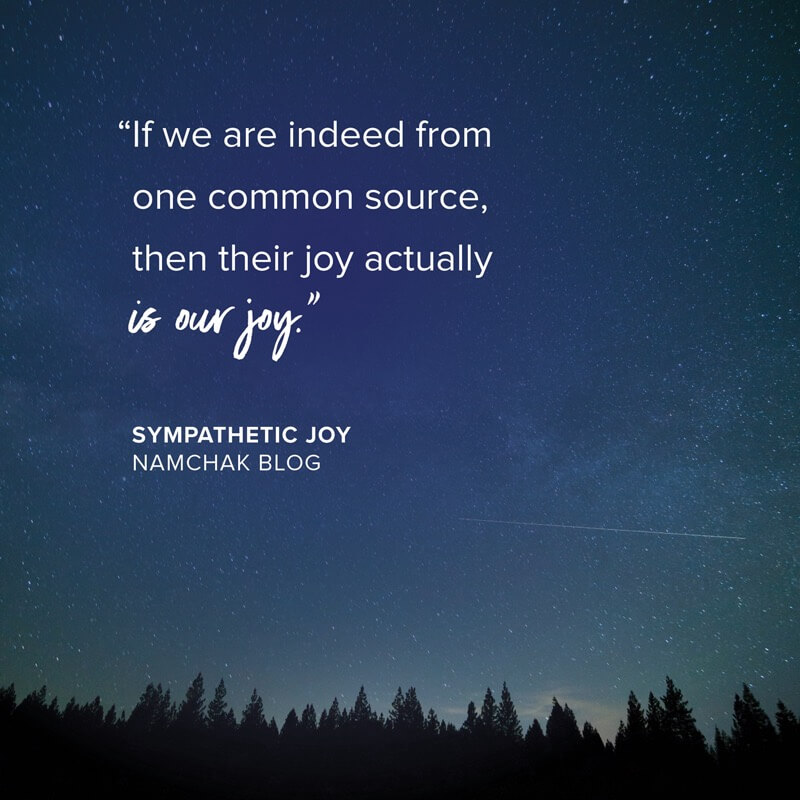Searching for happiness is a common theme in books, movies, TV shows, podcasts, and all kinds of media. One simple way to find happiness that you may not see in movies or TV is through the Buddhist practice of Sympathetic Joy, also referred to as Mudita in Sanskrit and Pali. In its most general sense, Sympathetic Joy means to be happy for others. For example, when someone you love has something wonderful happen, you feel a flush of joy right along with them! You might high five or hug each other—maybe even a happy dance! —for joy!

For simplicity, we will focus on Sympathetic Joy here, but know that the rest of the qualities include Compassion or Tonglen, Loving Kindness, and Equanimity. These emotions are considered the four highest states and will help you overcome their near and far enemies.
Sympathetic Joy (dga’ ba in Tibetan) is closely related to the act of rejoicing (rjes su yi rang). Rejoicing is the direct antidote to competitive attitudes (‘gran sems) and jealousy (phrag dog).
Generally, there’s nothing wrong with friendly competition. It can even be fun. However, anger, resentment, and jealousy grow when you lack appreciation for the qualities of the others involved. In all the movies, books, and media on happiness, you will not find anger, resentment, or jealousy on the path to happiness. If you engage in competition and lose to someone you respect and whose strengths you recognize and appreciate, you can accept your loss and sincerely congratulate them.
When you rejoice in the qualities of others, their success, intelligence, happiness, or the good works they do, you will feel genuine happiness for them. It’s easy to think, “Why didn’t I get what they have?” But the Buddha said that if you rejoice in the good deeds of others, you share in the merit of those deeds. And isn’t that what we want? To be a part of the good deeds or good fortune?

Sympathetic Joy meditation is the process of using breath, visualization, and presence to expand upon one of the Four Immeasurables or Boundless Qualities. Through this practice you create a shared sense of joy for others and their good fortunes.
How do I practice Sympathetic Joy?
Like all of the Four Immeasurables, Sympathetic Joy isn’t a passing sentiment. It is a capacity that you can cultivate. That’s why they call it practice! The basic progression is that you go from self, outward to others, gradually to all and everyone.
If you’re familiar with Tonglen, which is the practice of Immeasurable Compassion, then you know you’ll prime the pump, starting with yourself. Yes, you get to be happy for yourself! You get to celebrate some simple joy, such as a warm phone call with someone you love, or stepping out of the shower, fresh and clean. See and feel that moment, really sinking into it, savoring it, feeling your happiness. Then celebrate it—be happy for yourself! Ignore the cultural question of whether you deserve it.
Actually, since all beings emanate from one perfect source, and one ongoing quality of that source is joy, then joy is everybody’s natural state. We get plenty distracted from joy, but it’s our baseline, nonetheless. So be happy that you’re experiencing even a whiff of that, in this distracted world.
Now step it out to someone you already easily care for. You can think of anything that may be a source of goodness or happiness for them. Practice Tip: Avoid the urge to compare their good qualities with your own. Again, worthiness is quite beside the point! Instead, consider those qualities from the perspective of that person’s life and how those qualities are sources of happiness for them. With that change of perspective, you can begin to feel happy for them for having such goodness in their life. Without confusion or distraction, we would ALL be in a state of 100% joy all the time! You might even imagine hugging each other in celebration of that joy that you’re imagining.
After doing this with a couple of your loved ones, step it out to whole categories of people, such as those getting jobs they wanted, or eating a delicious meal at this moment, finding love, getting a new puppy, etc. Then you’ll step it out to everyone in your country, everyone in the world; even, perhaps, to animals. The goal is to make it Immeasurable by expanding that Sympathetic Joy to all beings. As you strengthen the Sympathetic Joy muscle, you’ll find that stronger capacity naturally showing up in your life. And through it all you’ll feel more deeply connected to everyone by sharing in their happiness. If we are indeed from one common source, then their joy actually is our joy.

Another method for developing Sympathetic Joy is to consider the faults of jealousy and the good feelings you get when you are happy for others.
Think of a time when you were jealous. How did you feel? How did you behave? How does it feel to look back on that time? In contrast, think about a time when you felt genuine joy for someone else’s happiness. Imagine when your best friend, brother, or sister got married, got the job of their dreams, or overcame a serious illness. Think of the joy you felt for them and how good that felt. When you meditate on Sympathetic Joy, you will begin to tap into that feeling in your off-the-cushion life.
Is joy Inherent? Is joy the same as Sympathetic Joy?
Here’s an important differentiation between joy and Sympathetic Joy in a Buddhist context. Buddhism teaches that joy is inherent and an aspect of thenature of your mind. In the sense of Sympathetic Joy of the Four Immeasurables, joy isn’t merely an energy of happiness, bliss, or brilliant awareness. Instead, it is a thought of appreciating and rejoicing in the meritsof others. In Buddhism, we would say that awareness and compassion are inherent and everything else is learned or brought about by the conditions ofour lives. That being said, even though compassion is an inherent quality, our inherent compassion can be covered up or obscured by other factors in our lives, so it’s important to commit to developing the capacity for Sympathetic Joy.

Here are some guided meditations from Lama Tsomo to help you develop and cultivate Sympathetic Joy. Remember, these are practices you can comeback to again and again. Through visualization and embodying the feelings of joy for others, we can learn to open our hearts and cultivate these positive emotions.
- 8-Minute Sympathetic Joy Beginner Guided Meditation
- 13-Minute Shamata, Sympathetic Joy, and Loving Kindness Guided Meditation
Book recommendations for further study:
The Way of the Bodhisattva by Shantideva
The Nectar of Manjushri’s Speech (commentary to The Way of the Bodhisattva) by Kunzang Pelden
Words of My Perfect Teacher by Patrul Rinpoche



